
|
| [an error occurred while processing this directive] |

Kate the Great by Matthew Murray
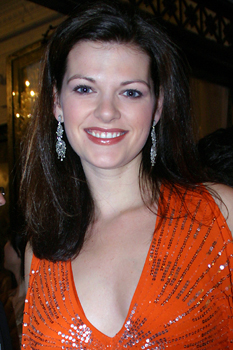 Looking at Kate Shindle today, you might not automatically think Miss America. Of course she's still as tall and beautiful today as when she was crowned in 1998, and her purposeful walk still bespeaks the traditionally determined pageant mien. But a streak of austerity has crept into her face and voice, and looking her in the eyes or talking to her for a few minutes is more like power-lunching with a Fortune 500 businesswoman than a New Jersey–born beauty queen.
Looking at Kate Shindle today, you might not automatically think Miss America. Of course she's still as tall and beautiful today as when she was crowned in 1998, and her purposeful walk still bespeaks the traditionally determined pageant mien. But a streak of austerity has crept into her face and voice, and looking her in the eyes or talking to her for a few minutes is more like power-lunching with a Fortune 500 businesswoman than a New Jersey–born beauty queen.
It's not so surprising that she's begun to assume this manner, as she's been living with it daily for the better part of a year. Since April, the 30-year-old actress has been appearing eight times a week in the Broadway musical Legally Blonde as Harvard Law student Vivienne Kensington, the hard-as-nails foil for hard-as-fingernail-polish Valley Girl Elle Woods (Laura Bell Bundy). While they're both fighting over Warner Huntington III (Richard H. Blake), their real conflict is whether the prestigious law school is big enough for both of them.
Though the plot of the musical greatly hinges on the stalemate the two achieve, Shindle's been tackling this challenge of her character ever since the earliest workshops of the musical with a book by Heather Hach and a score by Laurence O'Keefe and Nell Benjamin. "She feels under attack because her way of life is being attacked," Shindle says. "I thought, Vivienne can't just be a device in Elle's story....I was pretty aggressive in terms of sitting down with people and saying, 'We've got to think of her backwards. People who are mean don't turn nice. Think of her as a person who has the integrity and character and conscience to basically throw away her own legal career for someone she doesn't really like that much because it's the right thing to do.' It takes Elle the entire show to learn that Vivienne is right about certain things, [that] it's okay to be serious, it's okay to take yourself seriously and to be intelligent."
Shindle evinces plenty of both qualities—as well as a healthy sense of humor—in discussing her life and career. She got her start on stage at age four, when she played a Valentine's Day card in a school play. (Her one memorable line: "I don't want to go to the shop, I want to stay here!") This led to high school, where she made her musical debut playing Fruma-Sarah in Fiddler on the Roof (and, she wryly notes, doubling as one of only two violins in the orchestra pit), and eventually to Northwestern University in Evanston, Illinois, where she earned her B.S. in Theatre and pursued the pageant career that peaked with her earning the title of Miss America.
"You have to work really hard to regain your credibility coming out of a pageant," Shindle says. "It was kind of a Faustian bargain I didn't know I was making when I was 20: 'Ooh, a pageant may be fun!' But it definitely requires a sort of tasteful distance from it. I'm not ashamed of it, I'm really, really proud of what I did when I was Miss America, of what that program, almost in spite of itself, does to teach young women to be leaders in their communities."
She grudgingly admits her talent performance—"Don't Rain on My Parade," from the Jule Styne–Bob Merrill musical Funny Girl—wasn't all she would have wanted, but is still thrilled to talk about her platform issue: AIDS education and prevention. This involved lobbying for condom availability in schools, as well as "lots of other things that don't necessarily endear you to Miss America's core audience," she says. "I personally feel that although I grew up Catholic, we have a moral imperative to teach people to not die for stupid reasons. And there are so many people that would keep that information away from kids. It's amazing, I would go into schools and they would say, 'Don't say this word or that word,' and I wouldn't, but then I'd insist on an open question-and-answer period so that if the students asked me something, I could answer. They were always fine with that, because they couldn't imagine their kids would ask about condoms, but they always did. Every single time."
She also became the first Miss America to take her platform issue out of the United States when she spoke at the World AIDS Conference in Geneva Switzerland, and still cherishes the opportunities she had to communicate with young people about the dangers of the disease. "When you have the opportunity for people to tell you [about their lives], it's significant," she says. "If there's one thing people don't expect Miss America to be, it's of any significance whatsoever. Which is why I'm really defensive about it. When people introduce me as Miss America, it drives me crazy: "All the things you're about to think of me, please try to think the opposite, because it will make the rest of our relationship much easier."
Even so, she doesn't discount or disparage the talent of tomorrow from using methods like Miss America or American Idol as an entré to the big time. "I think all's fair. Like with anything, there's an upside and a downside. American Idol has developed a kind of thread, particularly on Broadway: If your album tanks, you can always come to Broadway. It at least gets you in the door. Do I question the wisdom of some of the casting choices? Sure, but I do that with regular people. Everybody's got an opinion, and they're often all over the place. When I got to the end of [my year as Miss America], there were plenty of people saying, 'You should move to Washington, we want you to work for our lobbying organization, and by the way, we're really excited about running your congressional campaign in ten years.' There weren't a lot of people saying, 'You should go to Hollywood.'"
She came to New York instead, in the fall of 1999, and dabbled in real estate as well as theatre. Her Broadway credits eventually came to encompass Jekyll & Hyde (where she eventually understudied the role of Lucy) and Cabaret, as well as more AIDS related work (such as producing a benefit performance of Stephen Schwartz's Children of Eden in 2003). But all the while, she was sowing seeds for the rest of her career, including Legally Blonde.
"One thing that I tell anybody who asks me, 'I'm a performer, what advice do you have for me?', [is to] sing every single time you get the opportunity to do it, for anyone who asks you. When I first got here, I used to go to Sam's on 46th and Ken Lundie played the piano late at night, and I would sing with him and I would start to meet some composers. I met Larry through a kind of circuitous route, and then when the first reading came up, he recommended me. I didn't know [director Jerry Mitchell], I didn't know anybody. I got in there and they just kept inviting me back. Which is awesome, I have to say. If I could get every job without auditioning, I would be the happiest girl in the world."
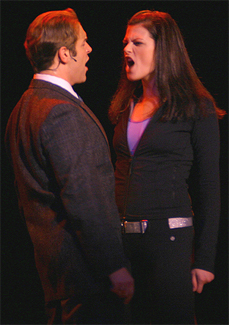 Her keeping her face and her voice out there have also led to collaborations with some up-and-coming talents, including choreographer Andy Blankenbuehler; musical-theatre writers Kait Kerrigan and Brian Lowdermilk, for whom Shindle appeared in their musical The Woman Upstairs in the inaugural New York Musical Theatre in 2004; and Masi Asare and Brooke Pierce, who wrote Sympathy Jones, in which Shindle starred at this past summer's NYMF.
Her keeping her face and her voice out there have also led to collaborations with some up-and-coming talents, including choreographer Andy Blankenbuehler; musical-theatre writers Kait Kerrigan and Brian Lowdermilk, for whom Shindle appeared in their musical The Woman Upstairs in the inaugural New York Musical Theatre in 2004; and Masi Asare and Brooke Pierce, who wrote Sympathy Jones, in which Shindle starred at this past summer's NYMF.
"I think it's a really good piece of material," Shindle says of the latter show. "It's smart, it's written by girls, which I like because women write for the female voice a lot differently than men do. No disrespect, because it comes in handy for me, but you shouldn't have every song have to top out at a B-natural or an F-sharp. I think people lose sight of that because they want the thrill, and a lot of male composers seem to find one part of the female voice exciting and that's all they write for."
And that high A-flat she belts at the end of Legally Blonde's climactic title song? "Well, that's my fault," she says. "It's like a party trick. That's an actor thinking, 'I'm in rehearsal and I started out this number and I want to get it back at the end... What can I do?' Ultimately, a lot of times young girls will ask me at the stage door, what note is that, how do you do that? And I'm really careful to tell them, 'Well first of all, you kind of have to be a natural soprano who's just not trained enough to be afraid of belting that high.' Which I am. And all of it comes half a step at a time. You just keep at it and you try to do the vocal puzzle and figure out how that singer's getting there. To have a 15- or 16-year-old girl say, "Well, that person can sing that so I should be able to as well" [could be trouble], so I try to be as responsible as possible when asked."
It's the coterie of young female fans, especially multiple return visitors, that has surprised Shindle most. "Our fans are really dedicated. It surprised me at first that people would latch on so thoroughly to a show like Legally Blonde. I understand if it's Spring Awakening or if it's Rent, if you feel like somebody's expressing something you've never connected with before as a 13- or 14-year-old. But I guess the lesson for me has been that a lot of these young girls do find a sort of profound connection with the show, that's why they keep coming back, I guess. They know their totals, too. 'Oh, this is my 51st time.' I can't say I entirely can understand what drives anyone to go to a Broadway show over and over again, but I'm glad they come, and I'm glad they bring new people with them.... It's a really nice group of people."
How many of those fans were cultivated as a result of MTV's decision to air the show in its entirety last fall? "I definitely have spoken to numerous people at the stage door who saw it on TV and couldn't wait to go see it. Obviously, the conventional wisdom was if you see it on TV you won't see it in person. But I think what a lot of people didn't appreciate was they didn't do this in a vacuum. They looked at market research on what that demographic does after they see something on TV that has a live experience. If you are a 12-year-old who sees a show on MTV that they'd really like to see in person, it's not like you can just buy a plane ticket and go to New York. So what I think everybody anticipated is it will really help the tour; they're sending [one] out in June. [The producers] weren't desperate to get the show on TV; if it hadn't been MTV who came to our show and said this might work for our audience, they probably wouldn't have pursued it."
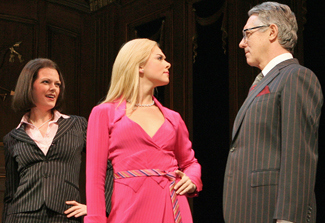 Shindle says the live taping (which was preceded by two days of rehearsals and additional photography) was "a blast...it was like they handed out thousands of Pixy Stix. It was really exciting, people who were cheering for the show, people who wanted to see the show succeed, even if it was just for that night.... It was a great experience." The only downside? The taping was during September, one of Shindle's most hectic months because of Sympathy Jones and a Birdland concert with Michael John LaChiusa she ended up canceling.
Shindle says the live taping (which was preceded by two days of rehearsals and additional photography) was "a blast...it was like they handed out thousands of Pixy Stix. It was really exciting, people who were cheering for the show, people who wanted to see the show succeed, even if it was just for that night.... It was a great experience." The only downside? The taping was during September, one of Shindle's most hectic months because of Sympathy Jones and a Birdland concert with Michael John LaChiusa she ended up canceling.
Still, Shindle's happy with her experience, and recently extended her contract until July. When we spoke, she didn't yet have any concrete information about the MTV reality show intended to find Bundy's replacement, though she says she's in favor of anything that brings new audiences to Broadway, and has nothing but glowing words for her costar. "I have no idea how she does [the role every night]," Shindle says. "And not only is she doing the show, she's doing a million press appearances, she has a very good attendance record, she's pitching TV shows and designing dog purses and releasing a CD... She's amazing. I feel like I'm busy, then I look at her and go, how are you not hospitalized?"
Shindle's busy-ness comes in the form of finishing her first novel, which she's been working on for five years, called Crown Chasers, a fictionalized account of the cutthroat world of beauty pageants. And she's just started working on her second book, a young-adult novel about a 16-year-old girl who learns she's a witch. (Which, she promises, is nothing like the Harry Potter series.) Her interests in writing came about as a result of a screenwriting class she took a number of years ago, because she was "tired of waiting for someone to let [her] be creative." Judging by all the stage credits she's been accumulating lately, Shindle's waiting days could well be over.
Photo credits:
(1) Kate Shindle, photo by Michael Portantiere
(2) Kate Shindle and Charlie Pollack in Sympathy Jones, photo by Michael Portantiere
(3) Kate Shindle, Laura Bell Bundy, and Michael Rupert in Legally Blonde, photo by Joan Marcus
Posted by Matthew Murray on Sunday, January 27, 2008 at 9:45 PM | Item Link
Archive of Matthew Murray's columns
What Once Was Lost by Matthew Murray
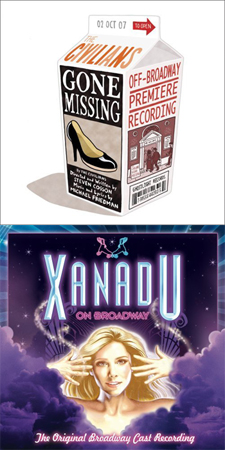 Reclamation as a subject or raison d'être for musicals is pretty uncommon, unless what's being recovered is someone's heart or soul. You know, boring stuff. But two musicals that made big splashes last summer and have recently released cast recordings exist for no other artistic reason than to prove that something you think is absent forever was merely only waiting for rediscovery.
Reclamation as a subject or raison d'être for musicals is pretty uncommon, unless what's being recovered is someone's heart or soul. You know, boring stuff. But two musicals that made big splashes last summer and have recently released cast recordings exist for no other artistic reason than to prove that something you think is absent forever was merely only waiting for rediscovery.
Of the two, Gone Missing is the more obvious application of this idea. A product of the Off-Broadway company The Civilians, the musical became a surprise hit when it opened at the Barrow Street Theatre early this past summer and ran until just a couple of weeks ago. As its title suggests, Gone Missing, constructed by Steven Cosson from interviews conducted by members of the company, focused on things we consider valuable but nonetheless lose: shoes, body parts, hearts, and sanity among them. In the theater, the show was a sweet tribute to the evanesence of life, performed by a game cast of unknowns and staged by Cosson as an often engrossing example of the anti-musical musical theatre so popular with today's cutting-edge troupes.
Michael Friedman's score is lively and varied, counting post-modern pop, Spanish, country, and German lieder among its styles, and it comes across broadly and well on the Ghostlight disc. But it was the spoken stories even more than the musical numbers that gave Gone Missing its unusual contemplative weight. Without them—and the cast recording features only the sparest fragments of dialogue—the recording plays far more sedately than the show itself did, coming across more as a lighthearted revue than a clear-eyed look at problems everyone can relate to. Few who hear the recording without seeing the show will be able to imagine how something that sounds so conventional was in fact one of the more daring musicals to hit New York stages in several seasons.
In contast, Xanadu is daring only by dint of its very existence: The idea that anyone, much less a respected playwright like Douglas Carter Beane (As Bees in Honey Drown, The Little Dog Laughed), would waste his or her time (or investors money) bringing to the Broadway stage one of the most catastrophic of cinematic flops, is too outrageously implausible to be believed. Yet because magic often happens where and when you least expect it, Xanadu turned out to be an avalanche of entertainment, with good reviews, respectable audiences, and now an invigorating PS Classics cast recording to prove it.
As with Gone Missing, you'll hear precious little dialogue. But the songs, by Jeff Lynne and John Farrar of Electric Light Orchestra, and the cast singing them, carry themselves so well that you won't feel you're missing out on even a second of the fun. With liquidy, disco-infused songs like "I'm Alive," "All Over the World," "Suspended in Time," and the title track, you'll find yourself transported back (whether you want to be or not) to the early 1980s, while still enjoying the vocal versatility of star Kerry Butler (in the role made infamous by Olivia Newton-John), the dopey Valley Boy of Cheyenne Jackson, the giddy grumpiness of Tony Roberts, and the magnificent mugging of villainous Muses Mary Testa and Jackie Hoffman. One of the few current cast recordings that's as great for parties as for solo listening, Xanadu is over the top, out of its league, and pointless to the extreme. But the show proves that an original-thinking playwright and Broadway's best performing talent can transform a failed experiment into a musical-comedy triumph.
********************
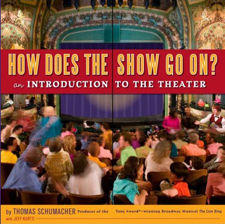 Can something be a lost opportunity if it succeeds mightily at what it attempts, but fails in the grander scheme of things? That's the burning question left by the gorgeous and often-thrilling new book How Does the Show Go On?: An Introduction to the Theater.
Can something be a lost opportunity if it succeeds mightily at what it attempts, but fails in the grander scheme of things? That's the burning question left by the gorgeous and often-thrilling new book How Does the Show Go On?: An Introduction to the Theater.
On one hand, it's as extravagant a tour through today's professional theatre as anyone could hope for. Its nearly 130 pages are packed with photos of productions onstage and off, dozens of performers and show-biz personnel from designers and stage managers to box-office workers and publicity folk. It also includes such above-and-beyond feelies like an actual Broadway ticket, the full show-listing section of a Playbill, costume sketches, detailed before-and-after demonstrations of stage makeup, and script and prompt-book pages. Awash in color, action, and insider information, it's quite simply the best-looking and most useful primer on the theatre for children I've seen in years—maybe ever. And it's priced at an astonishingly low $19.95.
The problem? Because it was written by Jeff Kurtti and Thomas Schumacher, the latter the president of Disney Theatrical Productions Ltd. and producer of The Lion King, and published by Disney Editions, it's not just mostly Disney—it's all Disney. Oh, if you search very carefully, you can find a few infrequent mentions of nonthreatening titles like Peter Pan, iconic talents like Cole Porter, and photos of a young Schumacher in South Pacific and Hello, Dolly!. Otherwise, the book focuses exclusively on Beauty and the Beast, The Lion King, Aida, On the Record, Tarzan, and Mary Poppins, with precious few acknowledgements that theatre exists if Disney doesn't have a white-gloved hand in it.
Of course, no one would expect Disney (or any production company) to provide hundreds of thousands of dollars of free advertising to its rivals. But by focusing on shows where budgetary concerns are essentially nonexistent and which are generally more concerned with extending brands than telling stories, How Does the Show Go On? spends so much time on the craft of theatre it has nearly no time left to discuss the art. (One of the few tidbits of note about writing concerns frequent Disney librettist David Henry Hwang: Since he apparently writes best horizontally, the producers provided him with a yoga mat so he could script new scenes during Tarzan rehearsals. If you saw Tarzan, insert your own joke here.) This does little more than perpetuate the kind of stunningly appointed but meaning-free theatre that has essentially been Disney's trademark for well over a decade.
This point of view is so intensely limited, and the stable of shows from which to draw so small, that How Does the Show Go On? ultimately seems like a crass attempt to produce more theatregoers for whom only the empty excesses of Disney shows will suffice. That makes this book, which on the surface is so beautiful, so informative, and so ceaseless positive, too dangerous to automatically recommend for the theatregoers of tomorrow. This razor-edged marketing tool should be handled with extreme caution by parents, and only bestowed upon their children if they've already learned the importance of substance over style—a lesson too often forgotten by the Disney musicals this book so loudly trumpets.
Posted by Matthew Murray on Tuesday, January 22, 2008 at 12:01 AM | Item Link
Archive of Matthew Murray's columns
The Music of the Night, Reconstructed by Matthew Murray
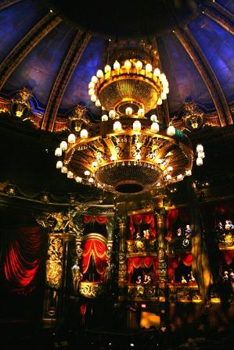 For once, the show doesn't start or stop at the edge of the stage. Look behind you to witness gently cavorting spirits all but escaping from the paint with which they've been etched into the walls. Or better yet, cast your gaze upward and marvel at the domed ceiling, punctuated with bits of Second Empire opulence that suggest nothing less than a first-rate house of imagination, pre-crumble. Even the load-bearing drop cloths adorning the wall elicit a certain rococo appeal.
For once, the show doesn't start or stop at the edge of the stage. Look behind you to witness gently cavorting spirits all but escaping from the paint with which they've been etched into the walls. Or better yet, cast your gaze upward and marvel at the domed ceiling, punctuated with bits of Second Empire opulence that suggest nothing less than a first-rate house of imagination, pre-crumble. Even the load-bearing drop cloths adorning the wall elicit a certain rococo appeal.
The history is so rich in the house that David Rockwell built that you might not notice—if only at first, and then depending on where you're seated—the ruins of a chandelier lost among the dross. Yet there they are, floating through space with all the precarious uncertainty of fragments of a fond memory at their most untidily kept. To any theatregoer worth his or her salt, these alone would identify a trip to The Phantom of the Opera, even if you were somehow unaware that you were visiting the Venetian Resort-Hotel-Casino in Las Vegas and had only unwittingly stumbled into what is called there The Phantom Theatre.
Rockwell's structure, designed specifically for the Vegas production, is indeed quite real. In fact, it seems the ultimate architectural vision for the now-ubiquitous work, the world-spanning Andrew Lloyd Webber-Charles Hart-Richard Stilgoe musical in its fullest and most corporeal form. But when the apparitions of ages past are swept away at the show's beginning, restoring the chandelier and the theater containing it to their former luster (leading the familiar Maria Bjornson set to melt into Rockwell's theater design), not every ghost is successfully exorcised. Lost in the ruins-cum-resplendence are the myriad details and felicities that have always identified Phantom as the finest work of the so-called "British invasion" of the late 1980s and early 1990s.
Though the show has rarely been taken seriously as storytelling, and is generally seen as less powerful than punchline-worthy today, the writers and director Harold Prince (who has returned for this production), it's always been deeper, richer, and more surprising than Les Misérables, Miss Saigon, Cats, and the lesser pop-opera hits that were its contemporaries. The focus has always been, and rightfully so, on Webber's romance-rich melodies and the carefully overwrought tale they delineate of the beautiful young chorus girl Christine who ascends to divadom with the help of her mysterious (and unseen) voice teacher, and who falls in love with Paris Opera patron Raoul—to the ghost's eternal consternation.
But in trimming Phantom from two and a half hours (with an intermission) to 95 minutes (without one), Prince has excised almost all of the connecting material that has always given the central romance what bite and suspense it had. Delightful supporting characters, particularly the opera's tempestuous lead soprano Carlotta and her tenor paramour Piangi, have been so whittled away that what has long felt like a three-character show now seems even more like one. The effects of the Phantom's reign of terror on the theater and its inhabitants, who also include the bumbling new managers and the stolid-but-knowing ballet mistress and her curiosity-driven daughter, are implied so vaguely someone unfamiliar with Phantom (is there such a person?), might not understand what all the fuss is about.
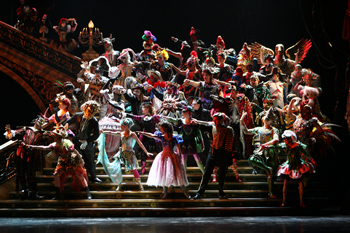 Not every change is for the worse. Many will rejoice at the deletion of all references to the Punjab Lasso, a plot device so intractable in the original that the only way to understand its implications was to read the libretto line by line. (This also leads to a far better trap effect in the protracted-trio finale.) The shortening of a few songs and the clipping of some lines of dialogue get the show where it needs to be more quickly than before. Prince has even relaxed the pacing of one number, "Prima Donna," which in recent seasons in New York has felt more like an evening at NASCAR than an operatic-weight septet. But the overall effect is one of an energetic tour guide, who gets you to every must-see location but does so at the expense of the context-establishing nuance that gives traveling—like theatre—its most significant meaning.
Not every change is for the worse. Many will rejoice at the deletion of all references to the Punjab Lasso, a plot device so intractable in the original that the only way to understand its implications was to read the libretto line by line. (This also leads to a far better trap effect in the protracted-trio finale.) The shortening of a few songs and the clipping of some lines of dialogue get the show where it needs to be more quickly than before. Prince has even relaxed the pacing of one number, "Prima Donna," which in recent seasons in New York has felt more like an evening at NASCAR than an operatic-weight septet. But the overall effect is one of an energetic tour guide, who gets you to every must-see location but does so at the expense of the context-establishing nuance that gives traveling—like theatre—its most significant meaning.
What's been removed has not been adequately compensated for by the rest of the production, which despite the new appellation "The Las Vegas Spectacular," still looks like the traditional Phantom at any given moment. The big exceptions are the chandelier, which now falls (and stops) at a terrifying speed and a new location in the story, and a new "entr'acte" in which fireworks, and the Paris Opera facade (designed by Paul Kelly, who adapted and added to the late Bjornson's designs) lead into the costumed revel (and unofficial theme statement) "Masquerade." This bits do ensure that you'll see something in Vegas you'll see nowhere else you can see Phantom, but add nothing to the story and, frankly, are somewhat less spectacular than hope and pre-publicity (the show opened at the Venetian about a year and a half ago) might lead you to believe.
Ultimately, it all comes back to the people onstage, and the cast I saw was by and large an enormously satisfying one. (Many of the roles are double-cast, so you may not see exactly this combination.) Kristi Holden was a pert, well-sung, and thoughtful Christine, a woman struggling for liberation against the bonds of two men who want to trap her for different reasons; Jason Forbach, on as Raoul in place of the billed Ryan Silverman, tamped his youthful energy down with an adventurous sense of propriety that made his later scenes as an action hero somewhat more convincing than usual. John Leslie Wolfe and Lawson Skala were solid as the managers, and Elena Jeanne Batman struck me as an all-around excellent Carlotta who deserved the chance to explore the full arc of the character as originally written. (In Vegas, she all but vanishes halfway through the show.)
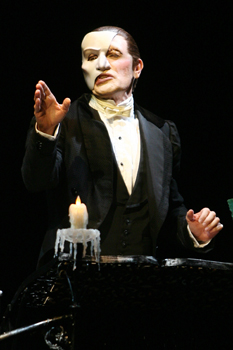 As the Phantom, Anthony Crivello ranks among the best I've seen, and is certainly one of the scariest: He plays, more than anyone else, the frightened child trapped within the man's twisted body, and stalks about the stage as a tortured mass of impetuous anger leavened only by the hope that love isn't forever beyond his grasp. His falsetto renderings of his songs' more tender passages (especially in "The Music of the Night") are caressingly lovely, his booming threats startling with their intensity, and his final moments equally comical and pitiful, when so many actors lose them in the harried act of wrapping up the plot.
As the Phantom, Anthony Crivello ranks among the best I've seen, and is certainly one of the scariest: He plays, more than anyone else, the frightened child trapped within the man's twisted body, and stalks about the stage as a tortured mass of impetuous anger leavened only by the hope that love isn't forever beyond his grasp. His falsetto renderings of his songs' more tender passages (especially in "The Music of the Night") are caressingly lovely, his booming threats startling with their intensity, and his final moments equally comical and pitiful, when so many actors lose them in the harried act of wrapping up the plot.
Crivello, shorn of that responsibility by the revisions that reduce the story to a bullet-point-riddled PowerPoint presentation, succeeds because of his fearlessness to plumb the depths of what makes men men. More than ever before, you see his Phantom as the alpha male to Raoul's prim metrosexual, the natural force balancing out the miracle of modern engineering. It's a battle that he's not destined to win. And it turns out only slightly better for the Phantom presenting his gorgeous-looking but pared-down story to audiences traditionally more interested in the surface-over-substance issues the Phantom himself rails so violently against.
(For tickets or more information about The Phantom of the Opera in Las Vegas, visit www.phantomlasvegas.com.)
Posted by Matthew Murray on Tuesday, January 15, 2008 at 6:45 AM | Item Link
|
|||
2007-08
Broadway Season
June 28 - Old Acquaintance (AA)
July 10 - Xanadu (Hayes) [Robert Ahrens, Dan Vickery, Tara Smith/B. Swibel and Sarah Murchison/Dale Smith]
Aug 19 - Grease (Atkinson)
Oct 4 - Mauritius (Biltmore) [MTC]
Oct 11 - The Ritz (54)
Oct 18 - Pygmalion (AA)
Oct 25 - A Bronx Tale (Kerr)
Nov 1 - Cyrano de Bergerac (Rodgers)
Nov 4 - Rock 'N' Roll (Jacobs)
Nov 8 - Young Frankenstein (Hilton)
Nov 9 - Dr. Seuss' How the Grinch Stole Christmas! (St. James)
Nov 10: Local One Strike Begins
Nov 28: Local One Strike Ends
Dec 2 - Cymbeline (Beaumont)
Dec 3 - The Farnsworth Invention (Music Box) [Dodger Properties with Steven Spielberg, Dan Cap Productions, Fred Zollo, Latitude Link and the Pelican Group]
Dec 4 - August: Osage County (Imperial) [Jeffrey Richards, Jean Doumanian, Steve Traxler, Jerry Frankel, Steppenwolf]
Dec 6 - The Seafarer (Booth)
Dec 9 - Is He Dead? (Lyceum)
Dec 16 - The Homecoming (Cort) [Richards, Frankel]
Jan 10 - The Little Mermaid (Lunt)
Jan 15 - The 39 Steps (AA)
Jan 17 - November (Barrymore)
Jan 24 - Come Back, Little Sheba (Biltmore)
Feb 21 - Sunday In The Park With George (54)
Feb 28 - Passing Strange (Belasco)
Mar 6 - Cat on a Hot Tin Roof (Broadhurst) [Stephen C. Byrd]
Mar 9 - In The Heights (Rodgers)
Mar 27 - Gypsy (St. James)
Mar 29 - Macbeth (Lyceum)
Apr 3 - South Pacific (Beaumont)
Apr 17 - A Catered Affair (Kerr) [Jujamcyn Theaters, Jordan Roth, Harvey Entertainment / Ron Fierstein, Richie Jackson and Daryl Roth]
Apr 24 - Cry Baby (Marquis)
Apr 27 - The Country Girl (Jacobs)
Apr 30 - Thurgood (Booth)
May 1 - Les Liaisons Dangereuses (AA)
May 4 - Boeing-Boeing (Longacre)
May 7 - Top Girls (Biltmore)
TBA - Godspell
2008-09
Broadway Season
Oct 16 - Billy Elliot (Imperial)
Nov 08 - Dividing the Estate (a Shubert theater)
Dec 14 - Shrek: The Musical (Broadway) [DreamWorks]
Talked About
Not Scheduled Yet
TBA - 50 Words
TBA - Addams Family (Elephant Eye)
TBA - American Buffalo
TBA - An American Vaudeville [Farrell, Perloff]
TBA - The Beard of Avon [NYTW]
TBA - Being There [Permut]
TBA - Benny & Joon [MGM]
TBA - Billy Elliot
TBA - Brave New World [Rachunow]
TBA - Breath of Life [Fox]
TBA - Busker Alley [Margot Astrachan, Robert Blume, Kristine Lewis, Jamie Fox, Joanna Kerry & Heather Duke]
TBA - Broomhilda
TBA - Bye Bye Birdie [Niko]
TBA - Camille Claudel [Wildhorn]
TBA - Camelot
TBA - Carmen [Robin DeLevita and The Firm]
TBA - Catch Me If You Can
TBA - Crouching Tiger, Hidden Dragon [Bob and Harvey Weinstein]
TBA - Cry Baby [Grazer, Gordon, McAllister, Epstein]
TBA - Designing Women [Alexis]
TBA - Don Juan DeMarco [New Line]
TBA - Dreamgirls [Creative Battery]
TBA - Duet
TBA - Equus
TBA - Ever After [Adam Epstein]
TBA - Fallen Angels (Shubert) [Kenwright]
TBA - Farragut North [Richards]
TBA - Father of the Bride
TBA - The Female Of The Species (TBA)
TBA - Fool For Love (AA) [Roundabout]
TBA - Girl Group Time Travelers
TBA - Golden Boy
TBA - Harmony [Guiles, Karslake, Smith, Fishman]
TBA - Hitchcock Blonde
TBA - The Importance Of Being Earnest
TBA - Jerry Springer: The Opera! [Thoday, McKeown]
TBA - Jesus Hopped The 'A' Train (Circle)
TBA - Josephine [Waissman]
TBA - Leap of Faith
TBA - A Little Princess [Ettinger, Dodger]
TBA - Midnight Cowboy [MGM]
TBA - The Minstrel Show - Kander and Ebb and Stroman
TBA - Moonstruck [Pittelman, Azenberg]
TBA - Mourning Becomes Electra [Haber, Boyett]
TBA - Monsoon Wedding
TBA - The Night of the Hunter
TBA - The Opposite of Sex [Namco]
TBA - Orphans
TBA - Pal Joey [Platt]
TBA - Paper Doll
TBA - The Paris Letter
TBA - The Philadelphia Story
TBA - Peter Pan
TBA - Porgy and Bess [Frankel, Viertel, Baruch, Routh, Panter, Tulchin/Bartner]
TBA - The Adventures of Priscilla Queen of the Desert
TBA - The Princess Bride
TBA - Princesses [Lane, Comley]
TBA - Poe the Musical
TBA - Rain Man [MGM]
TBA - Robin Hood
TBA - Secondhand Lions
TBA - South Pacific
TBA - Speed-the-Plow
TBA - Stalag 17
TBA - Starry Messenger
TBA - Syncopation
TBA - A Tale Of Two Cities
TBA - Torch Song Trilogy
TBA - Turn of the Century
TBA - West Side Story
TBA - The Wall [Weinstein, Mottola, Waters]
TBA - Will Rogers Follies [Cossette]
TBA - The Wiz [Dodger]
TBA - Zanna [Dalgleish]
This list is compiled from various sources. If you have corrections to the Broadway Season, please contact us.
Tim Dunleavy | James Marino | Matthew Murray | Ellis Nassour | Michael Portantiere
Blind Item | Contact Us | Legal | ?
© 1997 - 2010 2die4 Productions, Inc.
https://broadwaystars.com/matthew-murray/2008/01 | 172.69.130.28